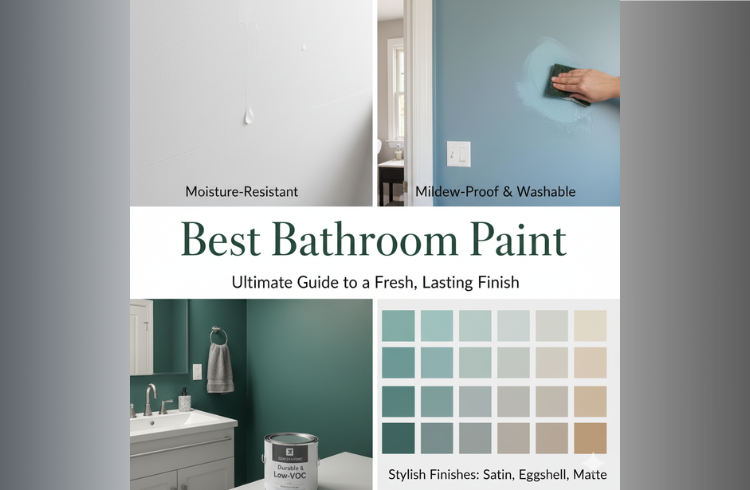Best Bathroom Paint
Bathrooms are one of the most demanding environments for wall paint. Constant steam, fluctuating temperatures, and poor ventilation can quickly turn a beautifully painted bathroom into a peeling, mold-prone mess.
This is why standard interior paint isn’t enough. Choosing the best bathroom paint requires understanding moisture-resistant technology, mildew-fighting additives, long-lasting finishes, and color psychology suitable for small or large spaces.
This guide will explore the best practices for selecting moisture-resistant paint, the importance of mold protection, various finishes, and color ideas that can transform your bathroom into a refreshing oasis.
| Type | Key Benefit | Recommended Finish / Color |
| Moisture-Resistant Paint | Prevents peeling in humid conditions | Satin or Semi-Gloss |
| Mold-Resistant Formula | Blocks mildew growth | Zinsser Perma-White, Behr Ultra |
| High-Durability Finish | Scrubbable and stain-proof | Semi-Gloss or Washable Matte |
| Low-VOC / Eco-Friendly Paint | Low odor and toxin-free | Benjamin Moore Natura |
| Light Color Options | Makes bathrooms feel larger | Soft White, Light Gray, Mist Blue |
| Bold Accent Colors | Adds contrast and depth | Navy, Charcoal, Forest Green |
Why Bathroom-Specific Paint Matters
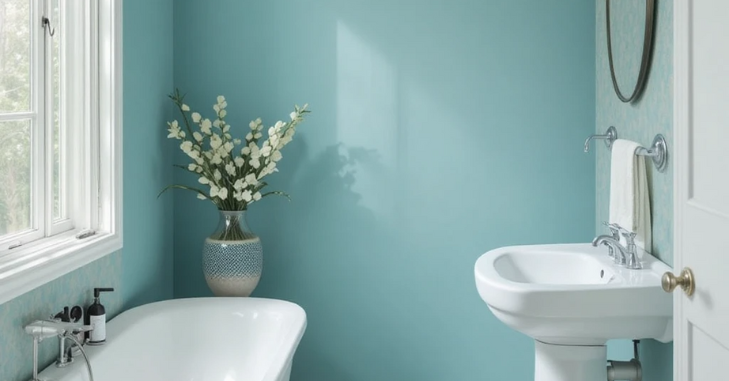
Bathrooms generate more humidity than any other room in the house. Even brief showers produce enough moisture to weaken poorly protected walls. Ordinary wall paint absorbs water, leading to bubbling, cracking, and discoloration. The best bathroom paint acts as a protective shield, resisting water droplets, blocking mold growth, and offering easy cleaning without scrubbing off the finish.
Key Benefits of Moisture-Resistant Paint
- Prevents mold and mildew buildup on walls and ceilings
- Reduces repaint frequency and long-term maintenance
- Improves overall air quality in closed or windowless bathrooms
- Allows steam to be wiped off without damaging the surface color
Bathrooms are no longer just functional spaces; they are now mini-retreats. Selecting the right paint quality and finish sets the foundation for a spa-like experience that stands the test of time.
Types of Bathroom Paint Finishes
Painting experts agree that the finish is just as important as color selection. A glossy or semi-gloss finish is often praised for its durability, but newer satin and matte variants now include washable and anti-mold technologies.
Most Suitable Finishes for Bathrooms
- Semi-Gloss — Excellent moisture resistance, ideal for high-splash areas like near sinks and showers
- Satin Finish — A softer sheen with easier touch-up capability, perfect for powder rooms
- Matte with Moisture Protection — Designed for luxury bathrooms that require a smooth, modern appearance without shine
Choosing a finish depends on how busy the bathroom is. Guest bathrooms can afford aesthetic finishes, while family bathrooms need heavy-duty protection.
Mold and Mildew Resistance: The Core Protection Layer
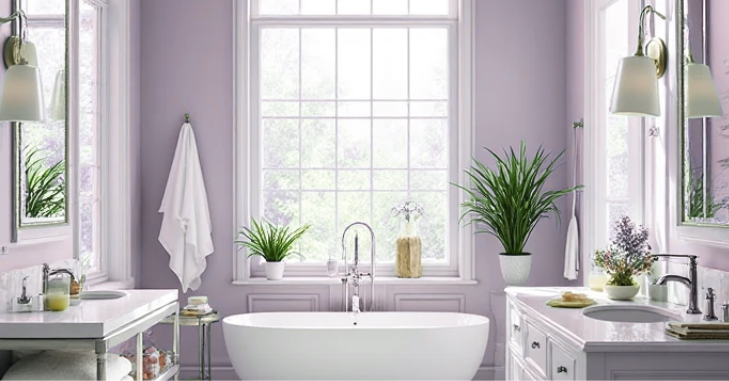
Mildew-resistant paint includes fungicidal additives that prevent microbial growth. This is crucial for ceilings where condensation gathers the most. Moisture alone doesn’t cause damage — trapped moisture is the real threat. If the paint doesn’t allow airflow or fails to resist bacterial buildup, discoloration will appear within months.
Top Paint Brands for Bathroom Durability
Leading manufacturers now design exclusive collections for high-humidity rooms. Some include built-in antimicrobial layers, while others offer stain resistance and scrubbability.
| Brand | Best Feature | Ideal Finish Option | Mold Protection Level |
| Benjamin Moore Aura Bath & Spa | Humidity-curing technology | Matte or Satin | High |
| Sherwin-Williams Duration Home | Stain-blocking formula | Satin | Moderate |
| Behr Premium Plus Kitchen & Bath | Budget-friendly coverage | Semi-Gloss | High |
| Zinsser Perma-White Mold & Mildew-Proof | 5-year mildew warranty | Eggshell or Satin | Very High |
| Valspar Reserve Interior | Washable and scuff-resistant | Satin | Moderate |
The right product depends on both appearance preference and moisture exposure level. Ceiling-specific bathroom paint is often overlooked, but essential for complete protection.
Best Color Ideas for Small and Large Bathrooms
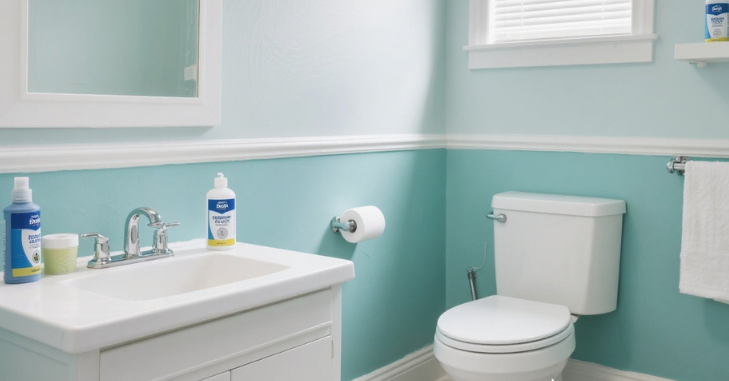
Color selection impacts lighting, perceived space, and overall mood. Bathrooms with limited natural lighting benefit from brighter tones, while spacious spa-inspired designs thrive with earthy neutrals.
Color Styling Guide
- Crisp white or pale gray makes compact bathrooms feel larger
- Soft aqua and pastel blue enhance a refreshing, marine-inspired look
- Muted sage and clay beige deliver a grounding, natural spa effect
- Charcoal or navy accents work best for statement vanities or trims
- Blush or peach undertones offer warmth without overpowering the space
Color harmony is key. Coordinating wall tone with tile shade or fixture texture ensures a seamless design that doesn’t clash under artificial lighting.
Accent Walls and Two-Tone Styling
Single-Color Paint Job
A single-color paint job is safe but sometimes flat. While it provides a clean and cohesive look, it may lack the visual interest some homeowners desire.
Two-Tone Painting
Two-tone painting adds dimension without complexity. This technique allows you to introduce color while maintaining a balanced aesthetic. For example, dark lower walls paired with a lighter upper shade can create a wainscoting effect without the need for installing panels.
Accent Walls
Accent walls behind mirrors or bathtubs draw instant attention and elevate an ordinary room. They serve as focal points, enhancing the overall design.
Recommended Accent Wall Placement
Accent walls can be strategically placed to enhance your bathroom’s aesthetic. For instance, positioning an accent wall behind freestanding tubs creates a stunning backdrop for a luxurious bathing area, making it a focal point of the room. Similarly, placing an accent wall adjacent to bathroom entry doors welcomes guests with a burst of color, setting a vibrant tone as they enter.
Color Coordination
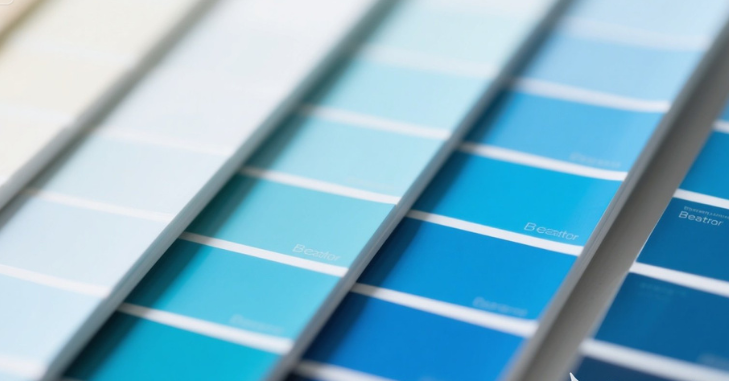
Accent paint should share undertones with the surrounding decor for a professionally designed finish. This ensures a cohesive look that ties the room together.
Application Tips for Long-Lasting Results
Bathrooms demand precision and patience during painting. Rushing leads to streak marks or peeling. Preparing the surface correctly ensures maximum paint adhesion.
Best Practices Before Painting
- Clean walls thoroughly using mild detergent or vinegar solution
- Fill small cracks and sand rough patches
- Apply mold-killing primer on old or stained areas
- Use painter’s tape around tiles, mirrors, and fixtures
Once prepped, applying two thin coats instead of one thick coat prevents drip lines while boosting longevity.
Bathroom Ceiling Paint Strategy
Ceilings receive the most moisture damage, yet are frequently neglected. Regular wall paint is not suitable for overhead application in bathrooms. Using flat or eggshell bathroom paint ensures low glare while withstanding steam exposure.
Bathroom-specific ceiling paint often includes condensation bead resistance, making water droplets slide rather than soak.
Ventilation and Paint Performance
Even premium bathroom paint can fail without airflow support. A combination of paint protection and ventilation ensures a lasting finish.
Essential Airflow Practices
- Install or upgrade exhaust fans with higher CFM ratings
- Keep doors slightly ajar after hot showers
- Open windows when the weather permits
Paint is the first line of defense — ventilation is the second.
When to Repaint a Bathroom
No paint lasts forever, and even mold-resistant coatings will gradually weaken over time. It’s essential to watch for signs of deterioration before damage spreads deeper into the drywall. Indicators that it’s time to repaint include light yellow spotting on ceiling edges, peeling near tubs or window frames, chalky residue appearing during cleaning, and a noticeable dullness or loss of sheen.
Long-Term Maintenance Habits
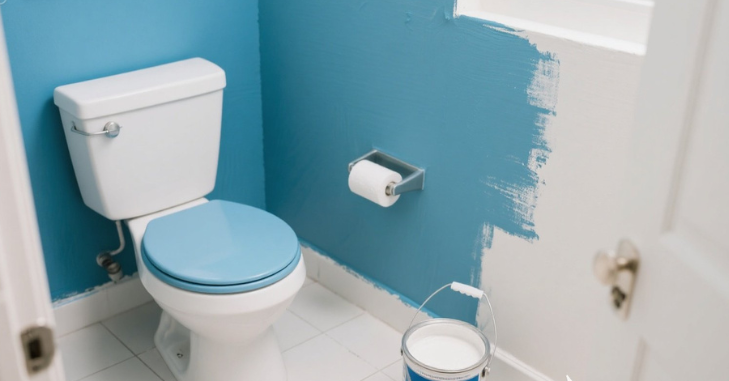
Routine upkeep extends the lifespan of bathroom paint dramatically. Simple cleaning habits prevent deterioration.
Gentle Care Techniques
- Wipe down walls weekly using a microfiber cloth
- Avoid harsh scrubbing agents or abrasive pads
- Reseal caulking around tiles to stop mold bridges
Proper maintenance saves both time and money, reducing repaint frequency by years.
Final Thoughts
High-quality bathroom paint isn’t a luxury; it’s a protective barrier safeguarding one of the most moisture-prone rooms in the house. By selecting the right formula, applying it correctly, and pairing it with good ventilation, homeowners enjoy long-lasting beauty without recurring mildew battles.
Moisture resistance, finish durability, and thoughtful color selection form the core pillars of a successful bathroom paint strategy. Whether aiming for minimalist elegance or bold character, choosing wisely ensures both visual and structural longevity.
Want to know about Can You Paint Vinyl Siding? Expert Tips and Proven Techniques for Achieving a Durable, Long-Lasting Finish Check out our Home Improvement category.
FAQs
When choosing an accent color, consider shades that complement the existing decor and share similar undertones. Test samples on the wall to see how they look in different lighting conditions.
Yes, you can paint over existing paint, but it’s essential to ensure the surface is clean and in good condition. If the existing paint is peeling or damaged, it should be scraped or sanded before applying new paint.
Light colors, such as soft whites, pastels, or light neutrals, can make a small bathroom feel larger. Adding accent walls can also create depth without overwhelming the space.
Priming is recommended, especially if you are painting over a darker color, bare drywall, or surfaces prone to mildew. It ensures better adhesion and coverage.

